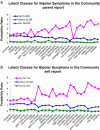Dimensions and latent classes of episodic mania-like symptoms in youth: an empirical enquiry
- PMID: 21625986
- PMCID: PMC3161193
- DOI: 10.1007/s10802-011-9520-8
Dimensions and latent classes of episodic mania-like symptoms in youth: an empirical enquiry
Abstract
The dramatic increase in diagnostic rates of bipolar disorder in children and adolescents in the USA has led to an intense interest in the phenomenology of the disorder. Here we present data from a newly-developed instrument to assess episodic mania-like symptoms in youth in a large population-based sample (N = 5326) using parent- and self-report. We found that a substantial proportion of children screened positive for having episodes of "going high" and were at an increased risk for morbidity and impairment. Using factor analysis, we identified that episodic mania-like symptoms comprised two dimensions: An under-controlled dimension that was associated with significant impairment, and a low-risk exuberant dimension. Using latent class analysis, we identified a small group of children scoring high on a range of manic symptoms and suffering from severe psychosocial impairment and morbidity. Our results carry implications for the nosology and psychosocial impairment associated with episodic mood changes in young people.
Figures



References
-
- Agresti A. Categorical data analysis. Hoboken: Wiley Interscience; 2002.
-
- American Psychiatric A. Diagnostic and statistical manual of mental disorders: DSM-IV-TR. Washington: American Psychiatric Press; 2000.
-
- Angst J, Gamma A, Benazzi F, Ajdacic V, Eich D, Rossler W. Toward a re-definition of subthreshold bipolarity: epidemiology and proposed criteria for bipolar-II, minor bipolar disorders and hypomania. Journal of Affective Disorders. 2003;73(1–2):133–146. doi: 10.1016/S0165-0327(02)00322-1. - DOI - PubMed
-
- APA . Diagnostic and statistical manual of mental disorders: DSM-IV-TR. Washington: American Psychiatric Press; 2000.
-
- Ayer L, Althoff R, Ivanova M, Rettew D, Waxler E, Sulman J, et al. Child behavior checklist juvenile bipolar disorder (CBCL-JBD) and CBCL posttraumatic stress problems (CBCL-PTSP) scales are measures of a single dysregulatory syndrome. Journal of Child Psychology and Psychiatry. 2009;50(10):1291–1300. doi: 10.1111/j.1469-7610.2009.02089.x. - DOI - PubMed
Publication types
MeSH terms
Grants and funding
LinkOut - more resources
Full Text Sources
Medical

